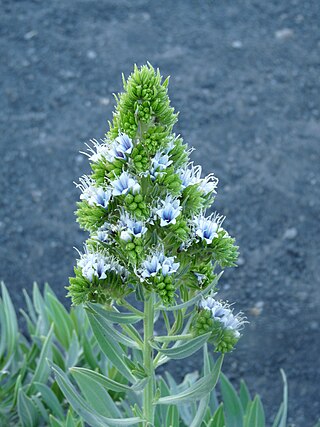Top Qs
Timeline
Chat
Perspective
Echium vulcanorum
Species of flowering plant From Wikipedia, the free encyclopedia
Remove ads
Echium vulcanorum is a species of flowering plants of the family Boraginaceae. The species is endemic to Cape Verde.[2] It is listed as an endangered plant by the IUCN.[1] The species was first described in 1935 by Auguste Chevalier.[3] Its local name is língua-de-vaca (cow tongue), a name that may also refer to the related species Echium hypertropicum and Echium stenosiphon.[4] The oil of its seeds contains γ-linolenic acid, and is used for medicinal and dietary purposes.[5]
Remove ads
Description

The plant is a very branched shrub that reaches 1–2 m height. Its leaves are lanceolate and 5-7 cm long and 1-1.5 cm wide. Its flowers are white, rarely bluish.[3] Although the plant can have flowers all year long, the most display occurs in the spring when the plant is covered in enormous, cone-shaped clusters of blossoms. Each funnel-shaped blossom has blue streaks radiating from its center and is pearly white with a length of little under an inch. Bees are very fond of the blossoms. Echium vulcanorum is a long-lived species that flower beautifully for several years, in contrast to many Echium species that only flower once before dying.[6]
Remove ads
Distribution and ecology
Echium vulcanorum is restricted to the island of Fogo, where it occurs between 1,600 and 2,400 m elevation, in semi-arid zones.[3]
References
Further reading
Wikiwand - on
Seamless Wikipedia browsing. On steroids.
Remove ads


